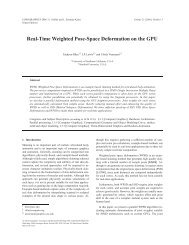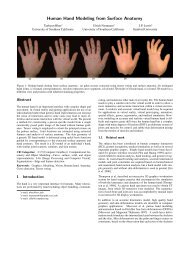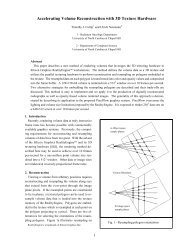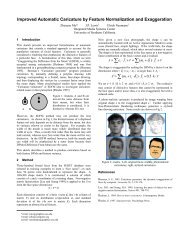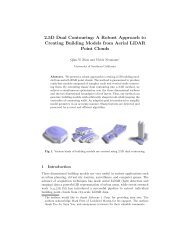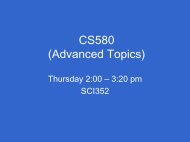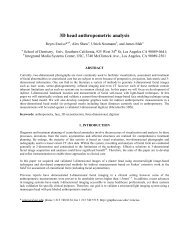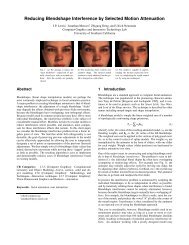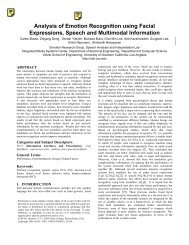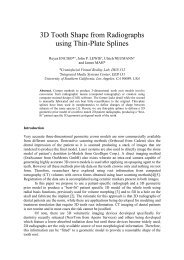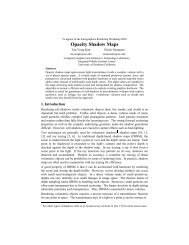Audio-based Head Motion Synthesis for Avatar-based Telepresence ...
Audio-based Head Motion Synthesis for Avatar-based Telepresence ...
Audio-based Head Motion Synthesis for Avatar-based Telepresence ...
Create successful ePaper yourself
Turn your PDF publications into a flip-book with our unique Google optimized e-Paper software.
imum TEE (its weights are the optimum weights) (Eq. 14-<br />
15). Here only four basic directions are considered: e1 =<br />
(α, 0, −α), e2 = (−α, 0, α), e3 = (0, α, −α), and e4 =<br />
(0, −α, α). α is the step size (experimentally set to 0.05 in<br />
this work)<br />
j = arg min<br />
i=1..4 T EE( Wt + ei) (14)<br />
Wt+1 = Wt + ej<br />
(15)<br />
The initial weight W0 is generated as follows: Wa is randomly<br />
sampled from the uni<strong>for</strong>m distribution [0..1], then<br />
Wn is randomly sampled from uni<strong>for</strong>m distribution [0...1-<br />
Wa], and Wr is assigned 1 − Wa − Wn.<br />
Non-sequential random Search [28] is used to avoid getting<br />
stuck at a local minimum in the weight space: a given<br />
number of initial weights are generated at random, then<br />
each initial weight per<strong>for</strong>ms an independent search, and finally,<br />
the winner among all the searches is the optimum<br />
weights. Fig 5 illustrates the search result after 20 initial<br />
weights are used. The resultant optimum weights W =<br />
[Wa = 0.31755, Wn = 0.15782, Wr = 0.52463].<br />
Figure 5: Plot of the search result after 20 initial<br />
weights are used (K=7). The global minimum<br />
is the red point, corresponding to the weights:<br />
Wa=0.31755, Wn=0.15782, and Wr= 0.52463.<br />
We argue that the optimum weights may depend on the<br />
subject, since the audio-headmotion mapping reflected in<br />
the constructed AHD may capture the head motion personality<br />
of the captured subject. Further investigation is needed<br />
to compare the optimum weights of different subjects.<br />
Since the number of nearest neighbors is discrete, unlike<br />
the continuous weight space, we experimentally set the optimized<br />
K to 7 using the following experiments: after K is set<br />
to a fixed number, the above searching method was used to<br />
search the minimum TEE. Figure 6 illustrates the minimum<br />
TTE with respect to different K.<br />
6. RESULTS AND APPLICATIONS<br />
6.1 Ground-Truth Comparison<br />
To evaluate this approach, ground-truth head motion is<br />
compared to the synthesized head motion. A speech segment<br />
that was not used <strong>for</strong> training and cross-validation is<br />
Figure 6: Plot of minimum TTE versus K. For each<br />
K, 20 iterations of non-sequential random search are<br />
used.<br />
used <strong>for</strong> comparisons, and approriate key head poses are also<br />
specified (only start head pose and ending head pose). Figure<br />
7 illustrates the trajectory comparisons of synthesized<br />
head motion and ground-truth one.<br />
6.2 Applications without Keyframes<br />
In many applications, such as avatar-<strong>based</strong> telepresence<br />
systems and computer games, automated head motion is required.<br />
This approach can be applied to these applications<br />
by simply setting Wa to zero. There<strong>for</strong>e, the head motion<br />
is guided only by the roughness and neighbor-distance criterias.<br />
In some cases, staying in the initial head pose is<br />
preferred, <strong>for</strong> example, the avatar speaking and paying attention<br />
only to one specific human subject, e.g. the user.<br />
By automatically setting key head poses to the initial head<br />
pose, the system can simulate these scenarios. Figure 8 illustrates<br />
some frames of synthesized head motion.<br />
6.3 Applications with Keyframes<br />
Although various automatic approaches were presented,<br />
keyframing is still a useful tool <strong>for</strong> animators. For example,<br />
in the case of the conversation of multiple avatars, head motion<br />
often accompanies turn-takings. There<strong>for</strong>e, animators<br />
can specify the appropriate key head poses, corresponding<br />
to the turn-taking time. This approach will automatically<br />
fill in the head motion gaps. If animators want the synthesized<br />
head motion to more closely follow key head poses,<br />
animators just need to increase the weight Wa.<br />
7. CONCLUSIONS AND FUTURE WORK<br />
In this paper, a data-driven audio-<strong>based</strong> approach is presented<br />
<strong>for</strong> automatically synthesizing appropriate head motion<br />
<strong>for</strong> avatar-<strong>based</strong> telepresence systems. The audio headmotion<br />
mapping is stored in a database (AHD), constructed<br />
from the captured head motion data of a human subject.<br />
Given novel speech (audio) input and optional key head<br />
poses, a KNN-<strong>based</strong> dynamic programming technique is used<br />
to find the optimized head motion from the AHD, maximally<br />
satisfying the requirements from both audio and specified<br />
key head poses. Keyframe control provides flexibility <strong>for</strong>


